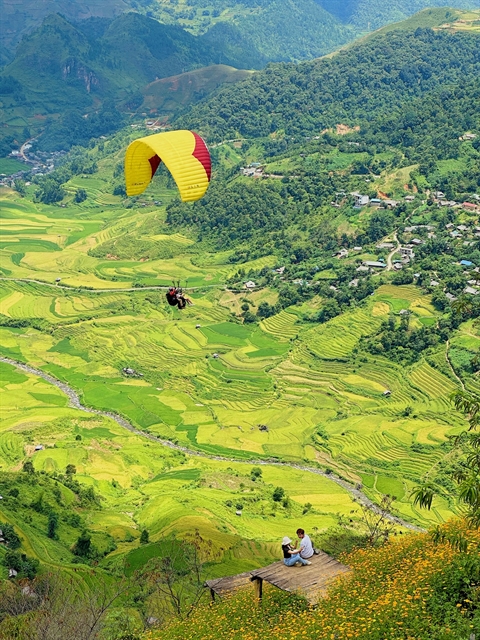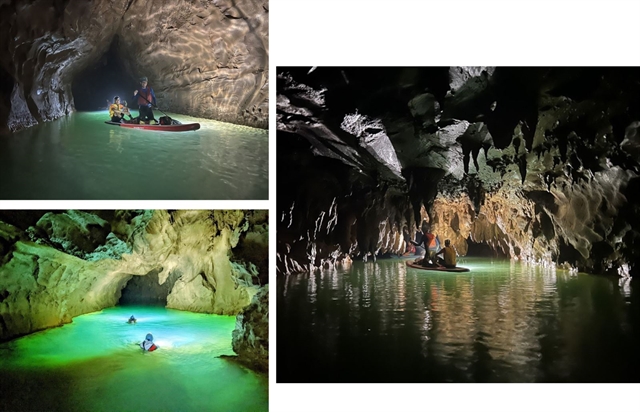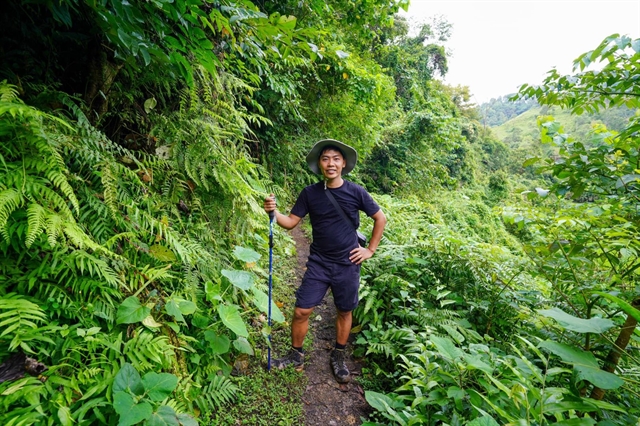 Sunday/Weekend
Sunday/Weekend

 |
| FREE AS A BIRD: Visitors experience paragliding at Cao Phạ Pass, Mù Cang Chải District, Yên Bái Province. Photo courtesy of Mebayluon Paragliding. |
Việt Nam's diverse terrain with forests, mountains, rivers and sea offers multiple opportunities for adventure tourism, which has been an increasingly popular trend in recent years.
However, experts say safety issues should be prioritised so that adventurous tours are sustainable and can develop as a key tourism product in the country.
Linh Tâm, a tourist from Đống Đa District, Hà Nội, felt scared thinking about exploring the 1,540m high peak of Phia Pò on the Mẫu Sơn Mountain Range in the northern province of Lạng Sơn.
The climb was self-organised by her and a group of friends, who were all fond of adventure travel as a way to discover and understand their capacity and to "live their passions and breathe the fresh air of nature".
 |
| TAKING FLIGHT: Ripe rice season from August to October is an ideal time of the year for visitors to fly paragliders and see the whole Khâu Phạ Valley. Photo courtesy of Mebayluon Paragliding. |
However, during the climb, due to darkness and poor organising, a member of the group fell and broke his leg. Although the group was helped by some locals, they did not return to the gathering point until 2am.
"It was a bad trip. Since then, whenever we organise a trip through the forest or climb mountains, we have to be more careful," Tâm said
Experts say adventure travel is risky if travellers are not highly careful in their preparations.
Recently, a car carrying four foreign tourists was suddenly carried away by floods, causing their deaths while they were exploring a stream in Lạc Dương District in the Central Highlands province of Lâm Đồng.
The incident raised the issue of safety management among localities and travel businesses providing adventure tourism services.
According to Nguyễn Tuấn Linh, director of Mr Linh's Adventures company, adventure travel is new in Việt Nam. Along with the free-to-travel trend, tourists often spontaneously organise their own trips, and do not strictly follow regulations or warnings on adventure tours.
“In addition, although tourism management has made many positive strides, various issues have emerged and need more attention. For example, the work in handling risks is poor while sanctions are not strict enough to prevent spontaneous and illegal adventure travel," Linh said.
 |
| CAVE DWELLERS: An exploration trip through the newly discovered caves in the western region of the central province of Quảng Bình. Photo baotintuc.vn |
He suggested several solutions to boost adventurous tourism and prevent it from becoming "risky tourism".
“Organisers and providers of this type of tourism must consistently update and equip their employees with knowledge, skills and professional training. They should carefully check the terrain, have a backup rescue plan, and disseminate regulations to ensure the safety of tourists during the trip. If we do a good job of preparing, we greatly reduce the risks. Safety must come first," Linh said.
The Director of the Institute for Tourism Development Research, Nguyễn Anh Tuấn, said: "Việt Nam has many advantages of mountains, caves, rivers and streams which show huge potential in developing adventure tourism with a relatively wide market."
He said adventure tourism products could be divided into different groups, such as aerial adventures by helicopter, paragliding, and skydiving; land adventures, as with mountain climbing, trekking, cave exploring, and abseiling; and water adventures such as rafting, boating, exploring waterfalls, and diving.
Many provinces and cities have strategies to promote adventure tours.
Typically, tourism agents in the Northwest region have provided tours to conquer Mt Bạch Mộc Lương Tử in Lai Châu Province, Mt Tây Côn Lĩnh in Hà Giang, Bản Giốc Waterfalls in Cao Bằng, and caves in Ba Bể National Park in Bắc Kạn.
 |
| STAYING ON TRACK: Nguyễn Tuấn Linh, director of Mr Linh's Adventures, takes survey trips before organising a trekking tour through the forest. Photo baotintuc.vn |
According to Tuấn, to sustainably develop adventure tourism professionally, promoting the strengths of tourism resources and local cultural identity needs to be the main focus. These do not need to be massive, but can be localised efforts.
"Absolute safety for tourists must be given top priority in all situations," he said.
Hoàng Hải, 36, a Hanoian travel addict who has many years travelling across Việt Nam, said that one of the most important things to consider before embarking on an adventure tour was to carefully read information on the geological and natural conditions of the destination.
"You can get the information from local authorities and residents. I often try to get in contact with a local guide and ask him for advice on how I should prepare for a trip. Sometimes, the guide will be my porter when we pass through a high-risk area," Hải said.
According to Hải, for trips that require high safety, travellers should choose reputable travel agents, particularly those that specialise in organising adventure trips.
In addition, if the adventure is self-organised, travellers should go in groups, pay attention to local warnings and comply with safety regulations, from clothing and vehicles to equipment.
Vũ Thế Bình, chairman of the Việt Nam Tourism Association, said regulations on adventure tourism had been issued, but the important thing was the implementation of travellers.
"This requires a stronger management role of the National Tourism Administration and localities," he said.
Exploration and adventure tourism has become a new trend, especially after the COVID-19 pandemic. The number of Vietnamese people participating in this type of tourism, mostly mountain trekking, has increased rapidly in recent years.
Some localities have provided attractive special events and tours such as survey tours and competitions. However, tourism experts warn that before developing adventure tour products, localities need to evaluate the impact and take on the lessons of the accident in Lâm Đồng.
Việt Nam's tourism development strategy to 2030 has oriented adventure tourism to one of the key tourism products of the country. Accordingly, several products can be developed such as paragliding, hot air ballooning, parachuting, rock climbing; abseiling, rafting, diving, mountaineering, and much more.
The sky is the limit when it comes to adventure tourism in the country, but it is absolutely imperative that no corners are cut when it comes to safety. VNS